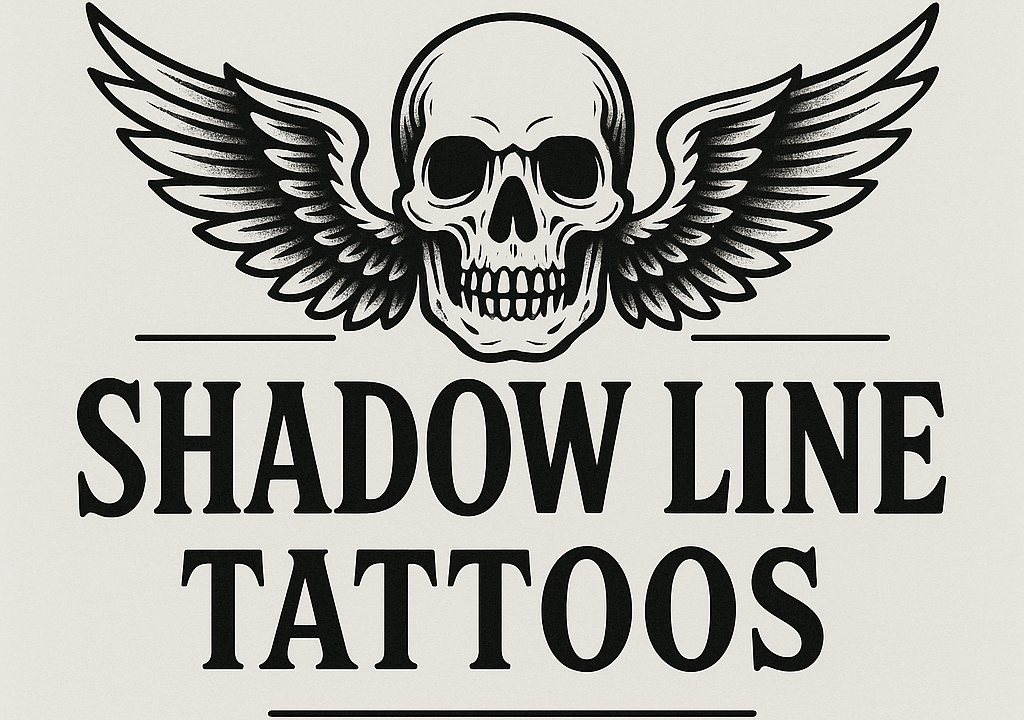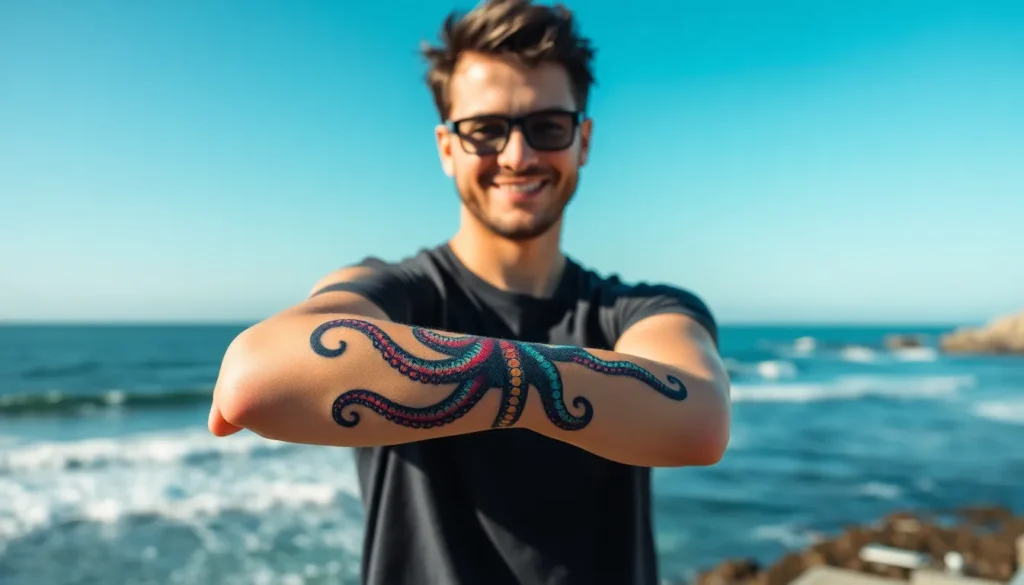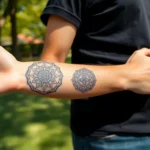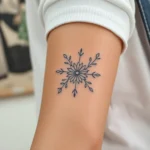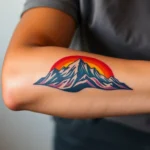Octopus tattoos have surged in popularity as one of the most captivating and versatile designs in modern body art. These mysterious sea creatures offer endless creative possibilities with their flowing tentacles and rich symbolism representing intelligence adaptability and transformation.
We’ve seen octopus ink designs evolve from simple black silhouettes to intricate masterpieces featuring realistic textures vibrant colors and ever-changing movement. Whether you’re drawn to minimalist line work or elaborate detailed pieces these marine-inspired tattoos work beautifully on various body placements from sleeves to backs.
The beauty of octopus tattoos lies in their ability to wrap around body contours naturally while incorporating personal elements like geometric patterns watercolor effects or nautical themes. We’re excited to share diverse design ideas that’ll help you discover the perfect octopus tattoo to match your style and personality.
Traditional Octopus Tattoo Designs
Traditional octopus tattoo designs form the foundation of modern cephalopod body art. These timeless approaches have shaped the evolution of octopus tattoos for decades.
Classic Black and Gray Realistic Style
Black and gray octopus tattoos showcase the creature’s natural beauty through stunning realism. We see these designs emphasize intricate tentacle details and lifelike textures that capture every sucker and curve. Master tattoo artists use advanced shading techniques to create depth and dimension that makes the octopus appear three dimensional on skin.
These realistic octopus designs work exceptionally well on larger body areas like the back, chest, or thigh. Artists often incorporate underwater elements such as coral reefs, seaweed, or rocky ocean floors to enhance the natural habitat setting. The monochromatic palette allows for incredible detail work while maintaining a classic, timeless aesthetic that ages beautifully over time.
Old School American Traditional Approach
American traditional octopus tattoos feature bold black outlines and vibrant color palettes typical of sailor tattoos. We find these designs using limited color schemes including red, blue, yellow, and green that create striking visual impact. The style emphasizes simplified forms and strong contrasts that make the octopus instantly recognizable from a distance.
Traditional American octopus tattoos often include nautical elements like anchors, ships, or compass roses that reflect maritime heritage. These designs typically feature fewer tentacles than realistic versions, focusing on bold, simplified shapes that follow classic tattooing principles. The style works perfectly for medium sized placements on arms, shoulders, or calves where the bold imagery can shine.
Japanese Traditional Octopus Motifs
Japanese octopus tattoos, known as tako in traditional art, carry deep cultural significance beyond mere decoration. We observe these designs incorporating flowing water patterns, cherry blossoms, and wave motifs that represent the ocean’s power and beauty. The Japanese approach emphasizes movement and energy through curved lines and ever-changing compositions that seem to flow across the skin.
Traditional Japanese octopus tattoos often feature rich color combinations including deep blues, vibrant reds, and golden yellows that create stunning visual narratives. These designs frequently include additional sea creatures like koi fish or dragons that complement the octopus while telling broader stories. The style requires skilled artists who understand traditional Japanese tattooing techniques and cultural symbolism to create authentic pieces that honor the art form’s heritage.
Geometric Octopus Tattoo Ideas
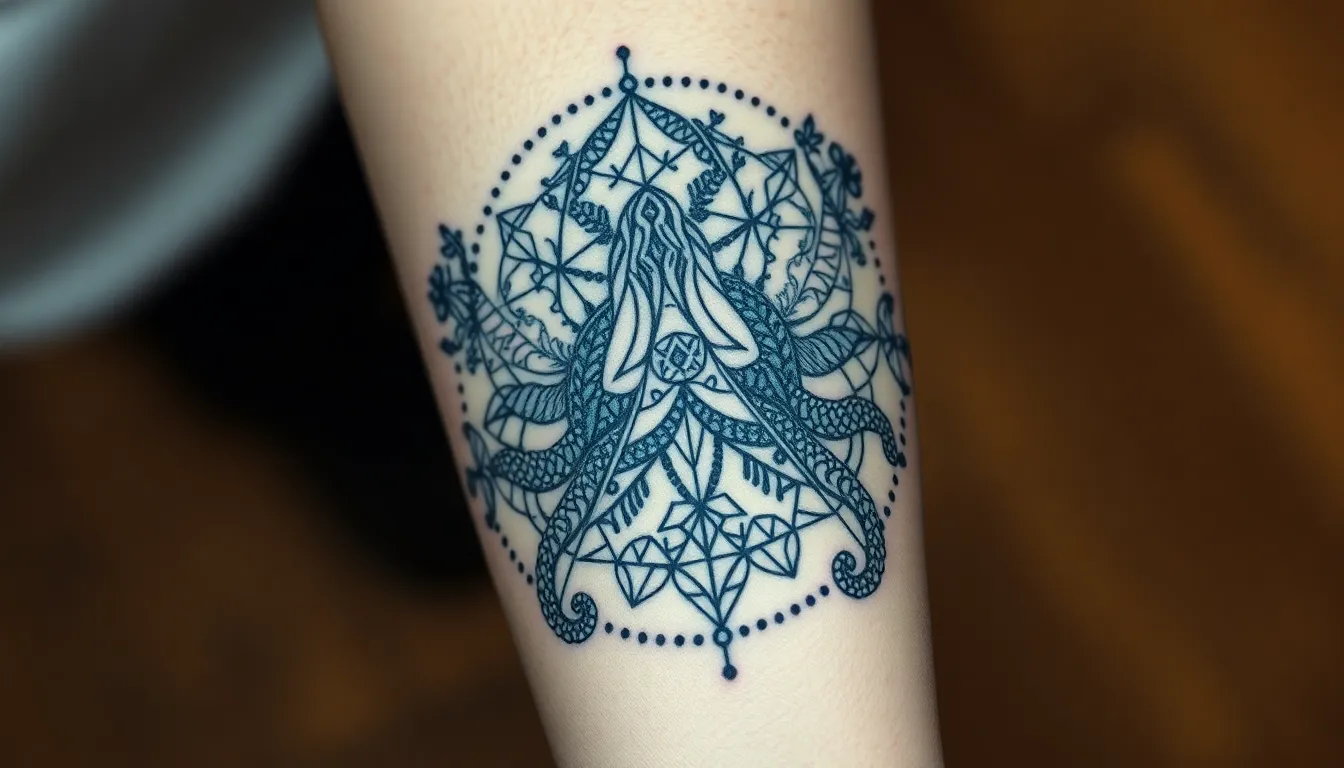
We’ve seen traditional styles dominate octopus tattoo art for decades, but geometric interpretations bring a modern edge to these cephalopod designs. Sharp lines and angular frames transform the octopus’s organic curves into striking contemporary artwork.
Sacred Geometry Integration
Sacred geometry patterns elevate octopus tattoos beyond simple marine imagery into meaningful spiritual symbols. Triangles, circles, and hexagons commonly frame the octopus form, creating designs that speak to both aesthetic and metaphysical sensibilities. Artists blend the creature’s natural intelligence symbolism with geometric precision, resulting in tattoos that represent both wisdom and universal harmony.
Complex mandala backgrounds often surround geometric octopus designs, while sacred ratios like the golden spiral mirror the octopus’s tentacle curves. These combinations create visually stunning pieces that honor both mathematical perfection and oceanic mystery.
Mandala-Inspired Octopus Designs
Mandala patterns merge seamlessly with octopus imagery to create tattoos emphasizing symmetry and intricate detail work. Eight tentacles naturally complement mandala’s circular structure, allowing artists to weave tentacles through geometric petals and sacred symbols.
Balance and harmony emerge as primary themes in these designs, reflecting the octopus’s remarkable adaptability alongside mandala’s spiritual significance. Dotwork techniques often enhance these tattoos, creating texture through carefully placed geometric points that follow mandala principles. Central octopus bodies frequently anchor elaborate circular patterns that extend outward through tentacle movements.
Minimalist Line Work Patterns
Simple lines and minimal details characterize these understated yet striking octopus interpretations. Single continuous lines often form entire octopus silhouettes, while negative space creates tentacle definition without heavy shading or color work.
Delicate placement areas like ankles, collarbones, and necks showcase these designs perfectly due to their subtle nature and small scale requirements. Fine line techniques using stick and poke methods produce crisp, clean results that maintain their clarity over time. These minimalist approaches appeal especially to those seeking their first tattoo or preferring discrete body art that still carries octopus symbolism’s powerful meaning.
Watercolor Octopus Tattoo Concepts
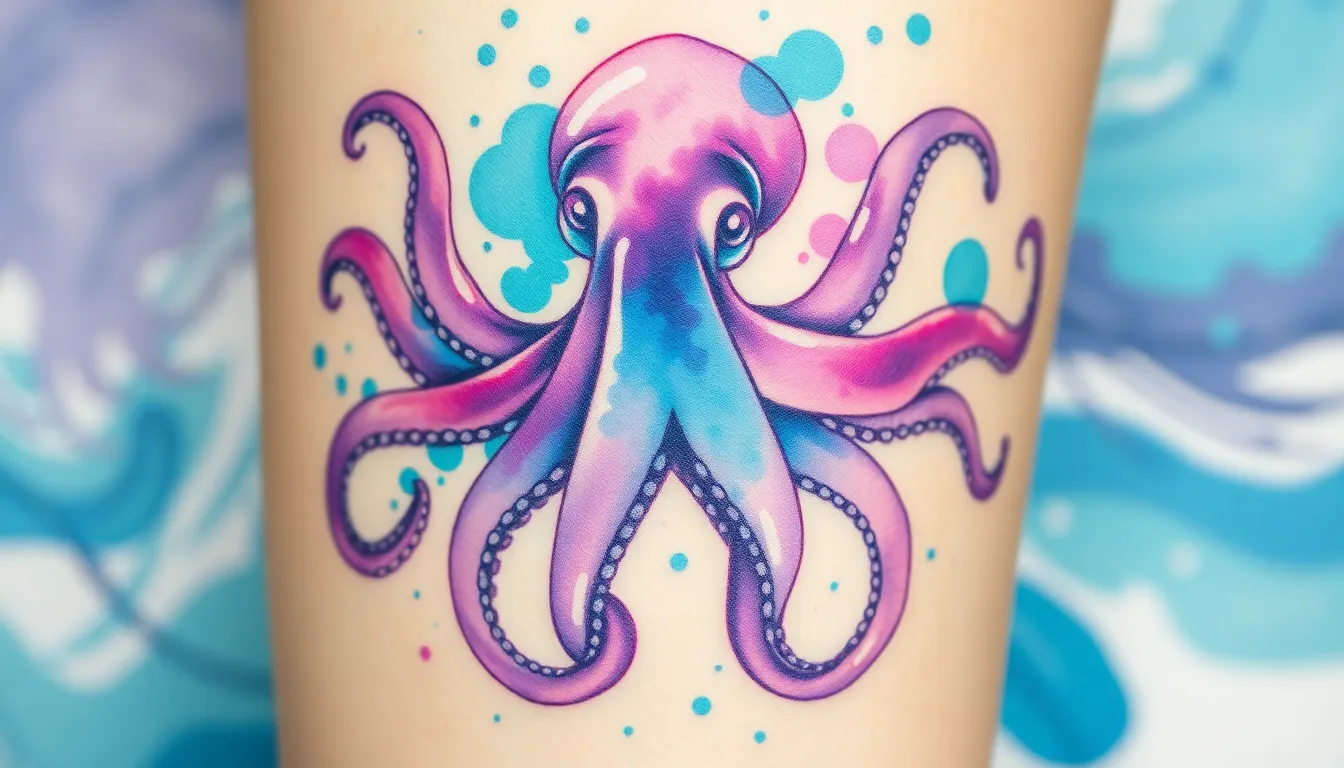
Watercolor techniques bring a dreamy, artistic quality to octopus tattoos that perfectly captures the fluid nature of these mysterious sea creatures. These designs feature soft, blended lines that mimic the graceful movement of octopuses through water, creating stunning visual effects that stand out from traditional tattoo styles.
Vibrant Splash Backgrounds
Colorful splash backgrounds transform octopus tattoos into ever-changing masterpieces that burst with energy and movement. Artists create these effects by layering bright blues, purples, and teals behind the octopus design, mimicking the natural ocean environment where these creatures thrive.
Ocean inspired elements like waves and coral formations often complement the splash effects, adding depth to the overall composition. Professional tattoo artists blend these colors seamlessly, creating backgrounds that appear to flow and shift like real water currents around the octopus figure.
Multiple color combinations work beautifully in splash backgrounds, from tropical turquoise and coral pink to deeper navy and emerald green palettes. The contrast between the detailed octopus silhouette and the free flowing background creates visual tension that draws the eye and holds attention.
Gradient Tentacle Transitions
Smooth color transitions along octopus tentacles create depth and visual interest that enhances the three dimensional appearance of the tattoo. Artists achieve this effect by gradually shifting from one color to another along each tentacle, often starting with darker shades at the base and lightening toward the tips.
Contrasting color combinations highlight the octopus’s natural camouflage abilities, showcasing how these creatures adapt their appearance in nature. Popular gradient combinations include deep purple fading to lavender, ocean blue transitioning to seafoam green, or sunset orange blending into coral pink.
Technical execution of gradient work requires skilled artists who understand color theory and blending techniques. The gradual color shift should appear natural and seamless, avoiding harsh lines or abrupt color changes that could disrupt the flowing aesthetic of the watercolor style.
Abstract Color Bleeding Effects
Dreamlike color bleeding effects create surreal atmospheres around octopus tattoos that emphasize their enigmatic and mysterious nature. Artists achieve this look by allowing colors to blend and flow beyond the defined lines of the octopus, creating organic shapes and patterns that suggest movement through water.
Creative freedom defines this artistic approach, as colors blend in unique and unpredictable ways that make each tattoo completely individual. The bleeding effect can extend outward from the octopus body, creating halos of color, or flow inward to create internal color variations within the design itself.
Unpredictable color combinations work especially well with bleeding effects, as the natural mixing creates new hues and tones that wouldn’t exist in more controlled applications. This technique allows for artistic expression that captures the fluid, ever changing nature of both water and the octopus’s ability to transform its appearance.
Neo-Traditional Octopus Tattoo Styles
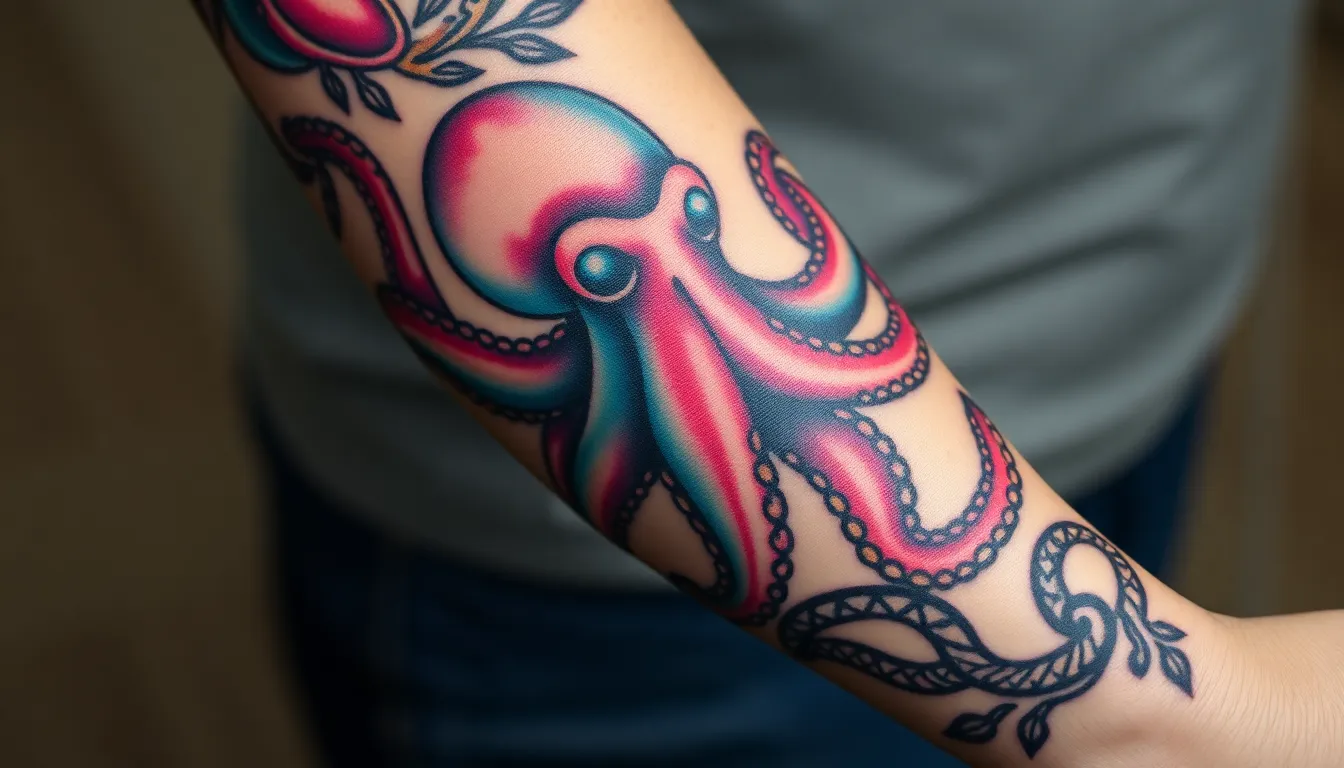
Neo-traditional octopus tattoos bridge the gap between classic tattoo artistry and contemporary design innovation. We’re seeing artists blend traditional techniques with modern approaches to create stunning oceanic masterpieces that capture both timeless appeal and current artistic trends.
Bold Line Work with Modern Shading
Bold outlines form the foundation of every exceptional neo-traditional octopus tattoo design. Artists employ thick black lines to define the octopus’s form while incorporating advanced shading techniques that weren’t available in traditional tattooing. Modern shading methods include soft gradients, realistic texture work, and three-dimensional depth effects that make tentacles appear to wrap around the body naturally.
Contrast becomes essential when combining bold lines with contemporary shading approaches. We’ve observed how skilled tattoo artists use varying line weights to create visual hierarchy, making certain tentacles pop forward while others recede into the background. Shadow work and highlighting techniques add sculptural quality to these designs, transforming flat traditional elements into ever-changing, lifelike representations.
Contemporary shading also allows for more realistic skin textures and suction cup details on octopus tentacles. Artists can now achieve photorealistic effects while maintaining the bold structural elements that define neo-traditional style.
Decorative Border Elements
Decorative frames elevate neo-traditional octopus tattoos from simple animal portraits to elaborate artistic compositions. We’re seeing artists incorporate ornate borders that complement the flowing nature of octopus tentacles, often featuring maritime elements like rope patterns, compass roses, or wave motifs. These borders serve as visual anchors that contain the organic movement of the design.
Floral accents frequently appear within these decorative frameworks, creating beautiful contrast between the sea creature and botanical elements. Artists weave roses, peonies, or coral formations around the border areas, improving the overall aesthetic appeal while maintaining thematic coherence.
Geometric patterns also work exceptionally well as border elements in neo-traditional octopus designs. We’ve noticed how hexagonal frames, art deco inspired shapes, and mandala influenced borders add sophistication while allowing the octopus to remain the focal point of the composition.
Contemporary Color Palettes
Modern color theory revolutionizes how we approach neo-traditional octopus tattoo designs. Artists now blend traditional bold colors with muted contemporary tones, creating sophisticated palettes that weren’t possible in classic tattooing. We’re seeing combinations of deep ocean blues mixed with coral pinks, seafoam greens paired with sunset oranges, and rich purples blended with metallic gold accents.
Color gradients and transitions have become signature elements of the neo-traditional style. Artists use smooth color flows to mimic the octopus’s natural camouflage abilities, shifting from one hue to another across tentacle surfaces. These transitions create visual interest while maintaining the bold impact that defines neo-traditional work.
Accent colors play crucial roles in bringing these designs to life. We’ve observed how strategic placement of bright highlights or unexpected color pops can make certain design elements stand out dramatically. Jewel tones like emerald green, sapphire blue, and ruby red add richness and depth to the overall composition while maintaining the vibrant energy that makes neo-traditional octopus tattoos so captivating.
Small and Minimalist Octopus Tattoo Ideas
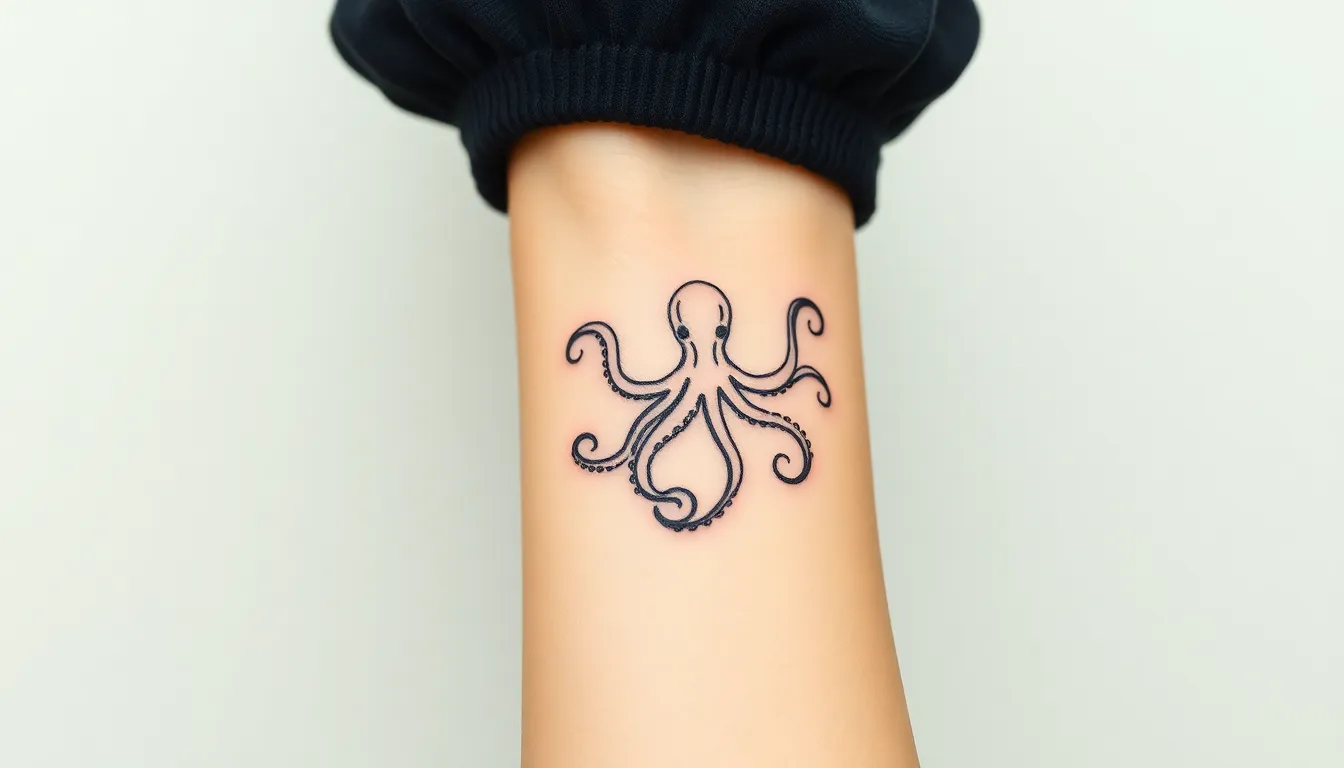
Small octopus tattoos offer the perfect balance between meaningful symbolism and subtle artistry. These delicate designs capture the essence of the octopus while maintaining an understated elegance that appeals to those seeking sophisticated body art.
Delicate Wrist Placements
Wrist octopus tattoos showcase simple outline designs that perfectly complement the limited canvas space. Artists focus on creating clean silhouettes that highlight the octopus’s distinctive shape against your skin, emphasizing grace over complexity.
Minimal details define these wrist placements, as intricate elements would become lost in such a small area. Tattoo artists typically omit elaborate textures and focus on essential forms, creating designs that remain crisp and readable over time.
Simple curved lines represent the tentacles, while a basic circular or oval shape forms the body. This approach ensures the design maintains its impact without overwhelming the delicate wrist area.
Simple Outline Designs
Basic shapes form the foundation of minimalist octopus tattoos, using circles, curves, and flowing lines to represent the creature’s essential features. These geometric elements work together to create recognizable octopus forms that feel modern and timeless.
Limited color palettes enhance the minimalist aesthetic, with many designs featuring single colors or just black outlines. This monochromatic approach adds sophistication while keeping the focus on the tattoo’s clean lines and balanced proportions.
Abstract representations reduce the octopus to its most fundamental visual elements, sometimes incorporating geometric patterns within the tentacles. Artists might use triangular shapes or diamond patterns to add visual interest while maintaining the design’s minimalist integrity.
Micro Tattoo Approaches
Tiny details within micro octopus tattoos require exceptional precision and artistic skill to execute effectively. These ultra small designs challenge tattoo artists to capture the octopus’s essence within spaces smaller than a coin, making every line crucial to the overall impact.
Precision becomes paramount in micro tattoo work, as small errors become more noticeable at this scale. Artists must carefully plan each element to ensure the design ages well and maintains its clarity over time.
Strategic placement options for micro octopus tattoos include behind the ear, on fingers, or along the ankle bone. These locations provide intimate canvas spaces where the tiny octopus can serve as a personal reminder of adaptability and intelligence.
Cute elements like small dots for eyes or simplified tentacle curves help micro designs maintain their charm without requiring complex details that might blur together as the tattoo heals.
Large Scale Octopus Tattoo Compositions
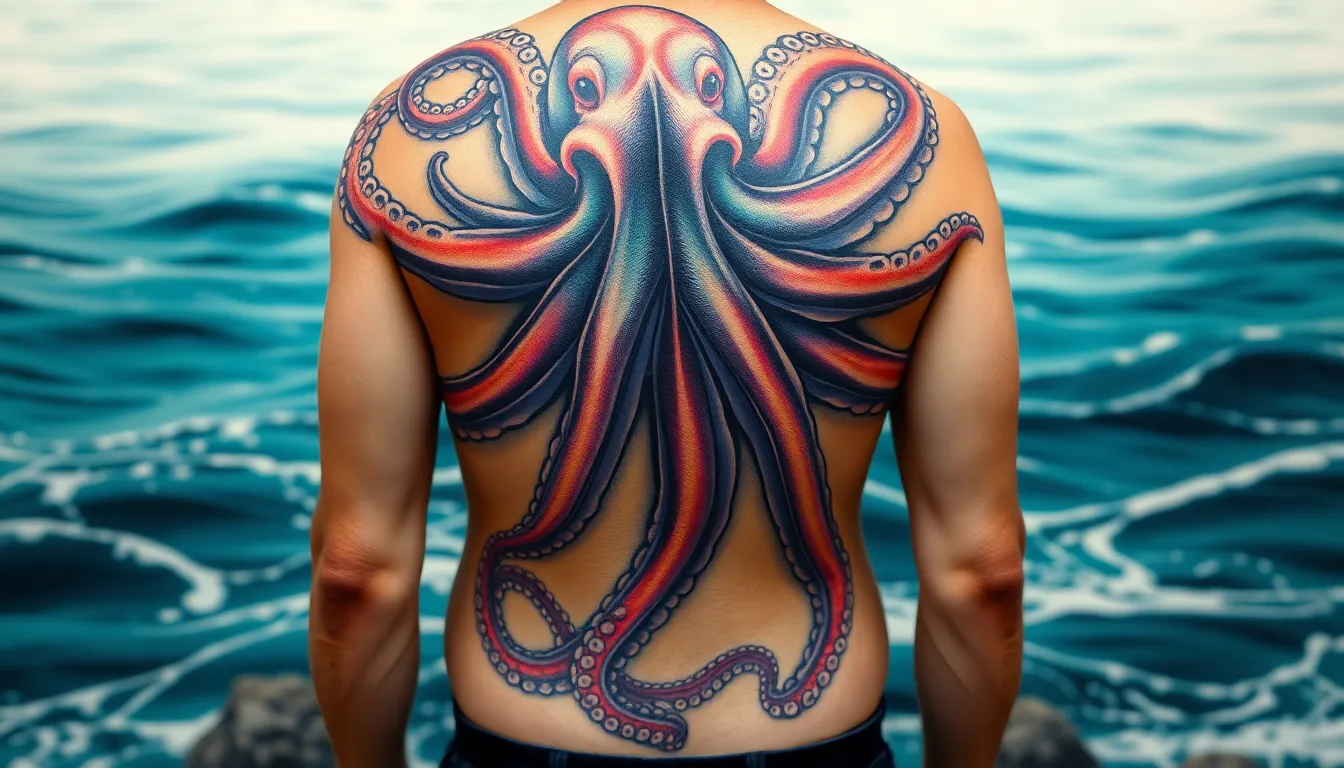
Large scale octopus tattoos transform expansive body areas into captivating underwater masterpieces. These compositions allow artists to showcase intricate tentacle details and create immersive oceanic environments.
Full Back Pieces
Full back octopus tattoos create panoramic ocean scenes that transport viewers to underwater worlds. We’ve seen artists position the octopus as the central figure amidst schools of fish and vibrant coral formations. These expansive canvases allow for detailed water movements and marine life interactions that bring the entire composition to life.
Artists often design tentacles to wrap around the body’s natural contours, creating seamless integration with the wearer’s physical form. The octopus’s eight arms can extend across the entire back surface, following the spine’s curve and embracing the shoulder blades. This approach creates a ever-changing flow that moves with the body’s natural movements.
Sleeve Integration Concepts
Sleeve octopus tattoos feature tentacle wrap designs that extend from the shoulder down to the wrist. These compositions blend the octopus with complementary marine elements like seaweed, anchors, and starfish for cohesive storytelling. We recommend starting with a bold, detailed octopus head at the shoulder and allowing the tentacles to spiral around the arm.
Gradual fading techniques create visual depth in sleeve designs, transitioning from vibrant colors at the shoulder to softer, more abstract elements toward the wrist. Artists achieve this effect by reducing color saturation and simplifying details as the design progresses down the arm. This technique maintains visual balance while allowing the octopus to remain the focal point.
Chest and Torso Placements
Chest octopus tattoos work best as symmetrical centerpieces, with the octopus head positioned over the heart and arms extending outward across the chest. This placement creates balanced compositions that follow the body’s natural symmetry. Artists often incorporate rib cage tentacle extensions that wrap around the torso sides for added dimension.
Ever-changing movement designs capture octopuses in motion, with curled tentacles flowing around the chest and torso areas. These compositions convey fluidity and showcase the octopus’s natural grace through strategic tentacle positioning. Artists use shading techniques to create depth, making tentacles appear to emerge from or dive beneath the skin’s surface.
Octopus Tattoo Ideas with Symbolic Elements
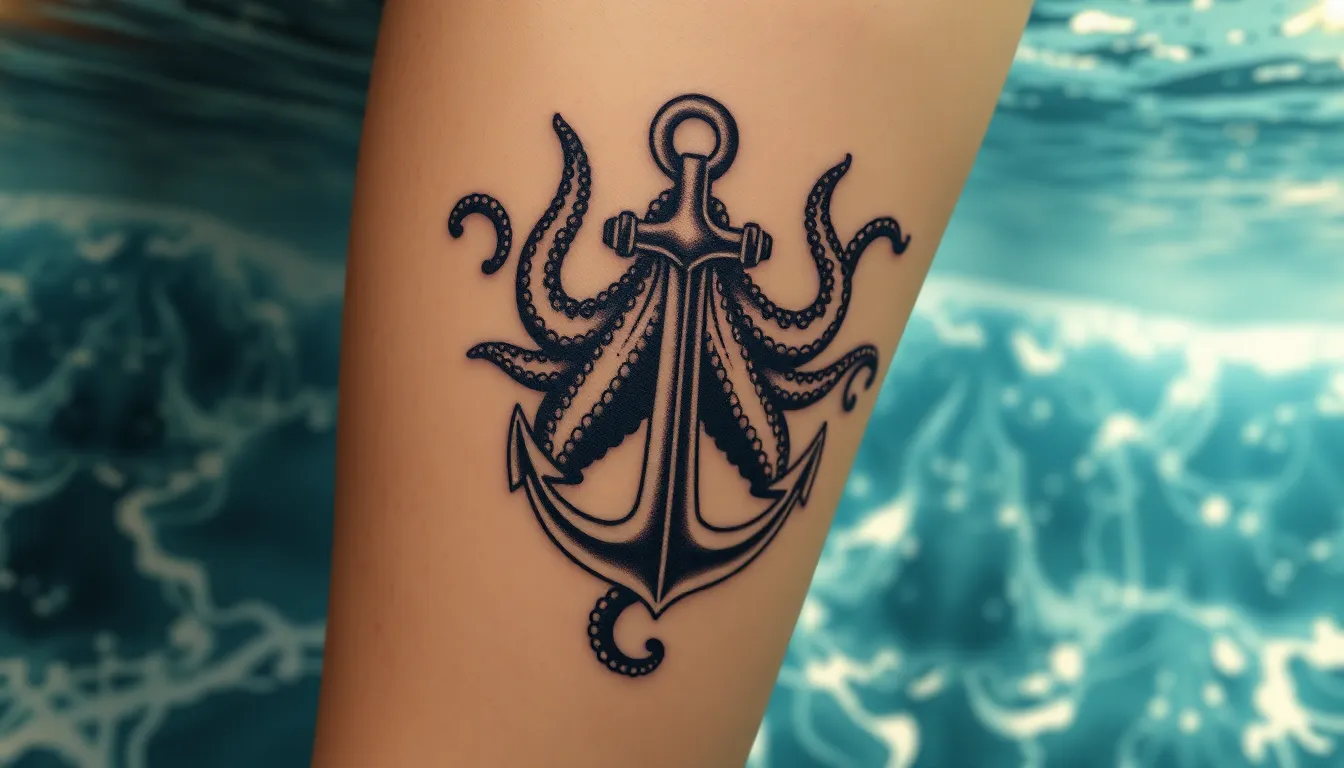
Symbolic elements transform octopus tattoos into powerful personal statements that go beyond aesthetic appeal. Artists combine these ocean dwellers with meaningful imagery to create designs that tell unique stories about the wearer’s journey and values.
Anchor and Nautical Themes
Anchors paired with octopuses create compelling contrasts between stability and adaptability in maritime-inspired designs. Tattoo artists often position octopus tentacles wrapping around sturdy anchors, symbolizing how flexibility can work alongside steadfast principles. Shipwreck elements add adventure and discovery themes to these compositions, with tentacles emerging from sunken vessels or treasure chests. Compass roses integrated with octopus designs guide wearers through life’s changing currents while maintaining their sense of direction. Rope details woven through tentacles emphasize nautical authenticity and represent the binding connections we make throughout our lives.
Ocean Wave Combinations
Waves flowing around octopus tentacles capture the creature’s natural grace and fluid movement through its aquatic environment. Artists create ever-changing compositions where tentacles seem to dance with rolling ocean swells, emphasizing themes of adaptability and going with life’s flow. Water droplets and splash effects add movement and energy to these designs, making the tattoo appear alive on the skin. Tide pool elements surrounding smaller octopuses create intimate underwater scenes that celebrate the creature’s coastal habitat. Sunlight filtering through water patterns adds depth and illumination, representing enlightenment and clarity emerging from life’s depths.
Skull and Gothic Influences
Gothic octopus designs blend beauty with darker symbolic meanings, creating tattoos that explore life’s mysterious depths. Skulls embraced by octopus tentacles represent the duality of creation and destruction, wisdom gained through life’s darker experiences. Dark color palettes featuring deep purples, blacks, and burgundies enhance the mysterious atmosphere these designs convey. Ornate Victorian elements like clockwork gears or antique keys intertwined with tentacles add steampunk influences that celebrate both innovation and the passage of time. Moon phases incorporated into the background emphasize transformation cycles and the octopus’s nocturnal nature, creating designs that speak to those who find meaning in shadow and light.
Creative Octopus Tattoo Variations
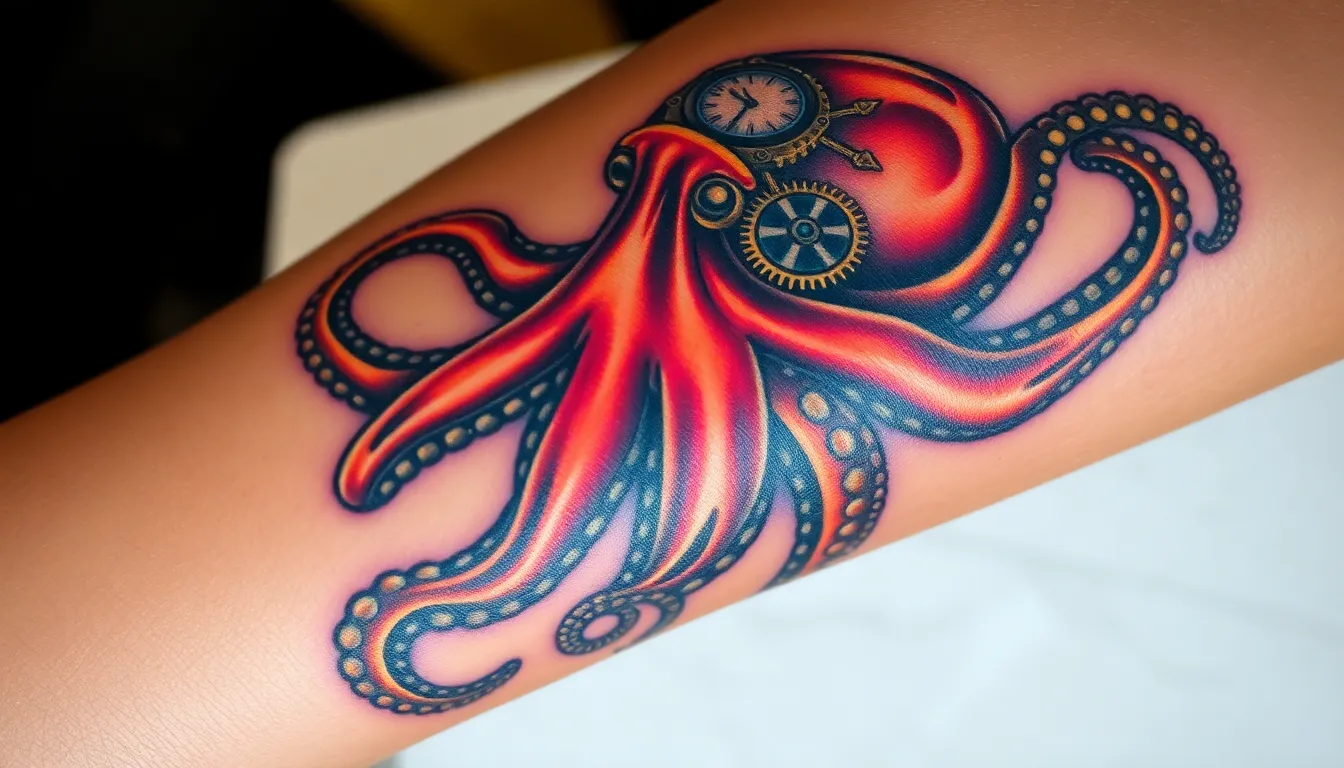
Beyond traditional and contemporary styles, innovative octopus tattoo variations offer endless possibilities for unique self-expression. These creative approaches blend different artistic movements and cultural influences to produce truly distinctive body art.
Biomechanical Hybrid Designs
Biomechanical octopus tattoos merge organic tentacles with mechanical components to create stunning fusion artwork. Artists integrate metallic gears, pistons, and circuit boards into the creature’s natural form, transforming portions of tentacles into robotic appendages. These designs often feature exposed mechanical parts beneath realistic skin textures, creating the illusion that your octopus is part living creature and part machine.
Technological elements like LED strips, hydraulic systems, and chrome plating add depth to these hybrid compositions. We’ve seen artists incorporate futuristic materials such as carbon fiber patterns and holographic effects into tentacle designs. The contrast between soft organic curves and hard mechanical edges creates visual tension that makes these tattoos exceptionally compelling.
Steampunk Inspired Elements
Steampunk octopus tattoos incorporate Victorian era industrial aesthetics with fantastical mechanical innovations. Clockwork mechanisms replace traditional tentacle suction cups, while brass gears and copper tubing weave throughout the design. Artists often add vintage diving helmets, submarine periscopes, and antique nautical instruments to enhance the retro futuristic atmosphere.
Copper and bronze color palettes dominate these designs, creating warm metallic tones that complement the octopus’s natural coloring. Steam pipes, pressure gauges, and intricate clockwork movements transform tentacles into elaborate mechanical appendages. We recommend incorporating elements like vintage compasses, brass anchors, and ornate Victorian scrollwork to complete the steampunk aesthetic.
Cartoon and Whimsical Styles
Cartoon octopus tattoos embrace playful designs with exaggerated features and cheerful expressions. These whimsical interpretations use soft pastel colors like lavender, mint green, and coral pink to create gentle, approachable artwork. Artists simplify tentacle shapes into smooth, rounded forms while adding cute elements such as oversized eyes, friendly smiles, and tiny hearts or stars.
Whimsical designs work particularly well for smaller placements on ankles, wrists, and behind ears where delicate details shine. We’ve observed that cartoon styles often incorporate kawaii influences with blushing cheeks, sparkles, and adorable accessories like tiny hats or bow ties. These lighthearted interpretations make octopus tattoos accessible to those preferring playful rather than intense body art.
Octopus Tattoo Placement Considerations
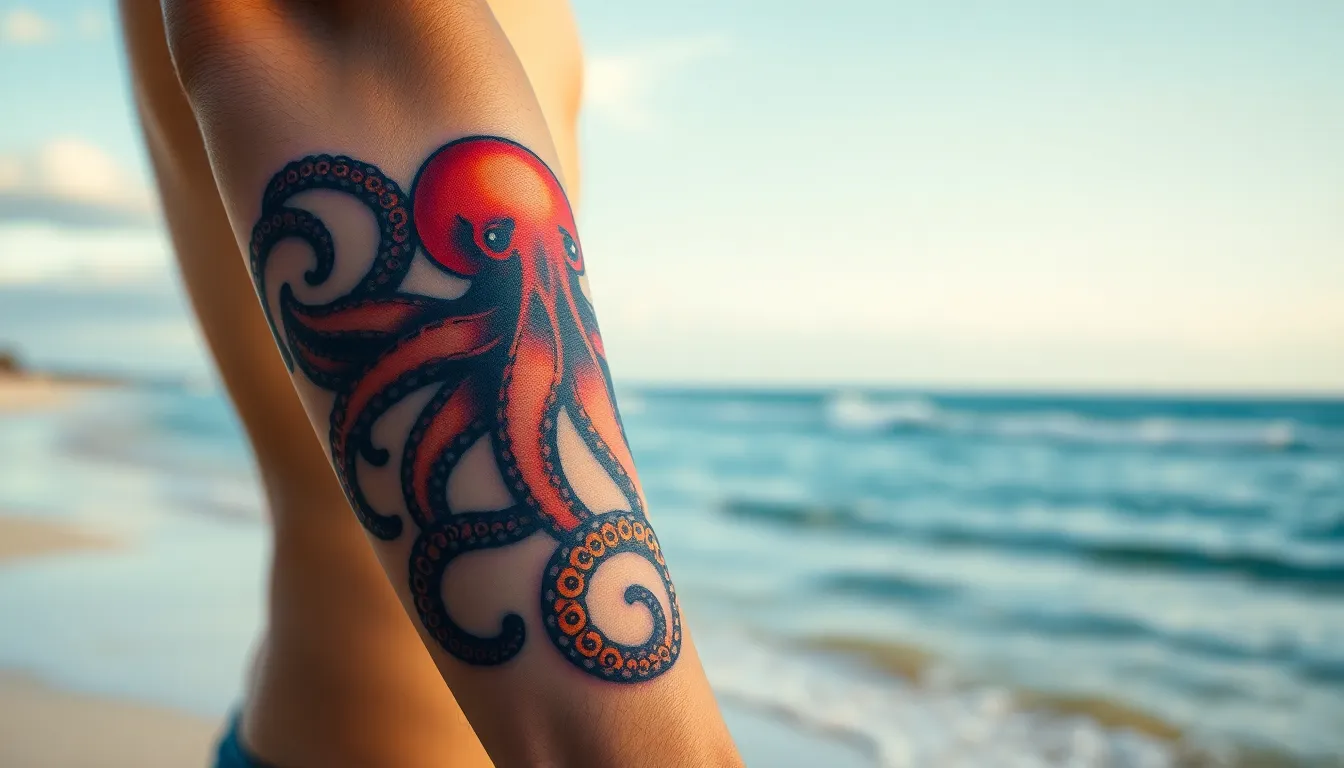
Choosing the right placement for your octopus tattoo significantly impacts both its visual appeal and personal meaning. Different body areas offer unique advantages for showcasing these intricate designs.
Arm and Shoulder Options
Forearm placements work exceptionally well for smaller octopus designs that you want to display prominently. This location allows the tentacles to flow naturally with your arm’s shape while remaining visible during daily activities. Upper arm positioning provides more canvas space for detailed artwork featuring multiple tentacles and oceanic elements.
Shoulder blade locations offer discretion when needed while still showcasing your tattoo when wearing sleeveless clothing. The curved surface of your shoulder creates natural movement that complements the octopus’s flowing tentacles. Bicep placements allow artists to incorporate larger designs that can extend onto adjacent areas for comprehensive compositions.
Full sleeve integration transforms your entire arm into an underwater scene where octopus tentacles can wrap around naturally. This approach works particularly well for neo-traditional and watercolor styles that benefit from extended space.
Leg and Thigh Positioning
Upper thigh placement provides ample room for detailed octopus designs while offering coverage flexibility based on your clothing choices. The flat surface area accommodates intricate tentacle work and allows for larger compositions that might include additional marine elements. This location works particularly well for realistic and traditional style octopus tattoos.
Calf positioning suits smaller to medium sized designs that remain visible yet modest in professional settings. The natural curve of your calf muscle enhances the organic flow of tentacles in your design. Ankle placements work beautifully for cute or minimalist octopus tattoos that serve as delicate accent pieces.
Thigh wrapping designs allow tentacles to curve around your leg’s natural contours, creating ever-changing movement that follows your body’s lines. This positioning works especially well for geometric and biomechanical octopus variations.
Back and Torso Locations
Upper back placements accommodate the largest octopus tattoo compositions, providing space for full underwater scenes with multiple design elements. The broad canvas allows artists to create panoramic ocean environments where your octopus can interact with other sea creatures and nautical symbols. This location works exceptionally well for traditional Japanese and watercolor styles.
Lower back positioning offers versatility for medium sized designs that can extend horizontally across your spine area. This placement allows for symmetrical compositions that emphasize the octopus’s natural balance and grace.
Chest and torso locations serve as striking centerpieces that showcase the octopus’s tentacles spreading across your body’s natural curves. Side placements allow designs to follow your ribcage lines, creating dramatic visual effects that emphasize the creature’s fluid movement. These locations require careful consideration of healing time and comfort during the tattooing process.
Conclusion
We’ve explored the intriguing area of octopus tattoos and their endless possibilities for creative expression. These remarkable designs offer something for everyone—from traditional black and gray masterpieces to vibrant watercolor creations and minimalist line work.
The beauty of octopus tattoos lies in their incredible versatility. Whether you’re drawn to geometric patterns that celebrate mathematical precision or whimsical cartoon styles that spark joy every octopus design tells a unique story about adaptability and intelligence.
Your perfect octopus tattoo awaits whether you choose a delicate wrist placement or a bold full-back composition. We encourage you to work with skilled artists who can bring your vision to life while honoring the rich symbolism these magnificent creatures represent.
Remember that the best tattoo is one that resonates with your personal journey and aesthetic preferences. Let your octopus tattoo become a powerful symbol of your own ability to adapt transform and thrive in life’s ever-changing tides.
Frequently Asked Questions
What do octopus tattoos symbolize?
Octopus tattoos represent intelligence, adaptability, and transformation. These sea creatures are known for their problem-solving abilities and capacity to change colors and shapes, making them powerful symbols of flexibility and personal growth. Many people choose octopus tattoos to represent their ability to overcome challenges and adapt to life’s changes.
What are the most popular octopus tattoo styles?
The most popular styles include traditional black and gray realistic designs, old school American traditional with bold outlines, Japanese traditional motifs with cultural significance, modern geometric patterns, watercolor techniques, and neo-traditional blends. Each style offers unique artistic approaches, from intricate details to bold, colorful compositions.
Where is the best place to get an octopus tattoo?
Popular placement options include forearms, upper arms, shoulders, thighs, calves, backs, and chests. The best location depends on your desired tattoo size and style. Larger, detailed designs work well on backs or thighs, while smaller, minimalist octopus tattoos are perfect for wrists or behind the ear.
How much do octopus tattoos typically cost?
Octopus tattoo costs vary significantly based on size, complexity, artist experience, and location. Small, simple designs may cost $100-300, while large, detailed pieces can range from $500-2000 or more. Always consult with your chosen tattoo artist for accurate pricing based on your specific design requirements.
Are octopus tattoos suitable for beginners?
Yes, octopus tattoos can work for first-time tattoo recipients. Simple, minimalist designs are perfect for beginners, while more complex pieces suit those ready for larger commitments. The flexible design allows for various sizes and styles, making it easy to find an octopus tattoo that matches your comfort level.
How long does an octopus tattoo take to complete?
Completion time depends on the tattoo’s size and complexity. Small, simple octopus designs may take 1-2 hours, while detailed full-back pieces can require multiple sessions spanning 10-20 hours total. Your tattoo artist will provide a more accurate timeline during your consultation based on your chosen design.
Do octopus tattoos age well over time?
When done by skilled artists with proper aftercare, octopus tattoos age well. Bold outlines and solid shading techniques help maintain clarity over time. Minimalist designs with clean lines also tend to age gracefully. Regular touch-ups and sun protection help preserve the tattoo’s appearance and vibrancy.
